 W
WA feral parrot is a parrot that has adapted to life in an ecosystem to which it is not native. Many are descended from pets that have escaped or been deliberately released. Feral parrots may affect native biodiversity, human economy and wellness.
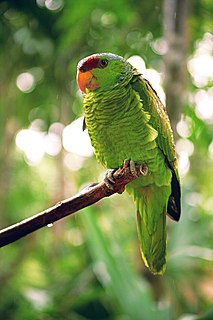 W
WThe lilac-crowned amazon is a parrot endemic to the Pacific slopes of Mexico. Also known as Finsch's amazon, it is characterized by green plumage, a maroon forehead, and violet-blue crown and neck.
 W
WThe red-crowned amazon, also known as the red-crowned parrot, green-cheeked amazon or Mexican red-headed parrot, is a highly social, endangered amazon parrot native to northeastern Mexico and the southwestern United States. The current native wild population of between 1,000 and 2,000 is decreasing. The main threats to the native bird's survival are the illegal export of trapped birds from Mexico to the United States for the pet trade and the destruction of their natural habitat, the lowland forests of northeastern Mexico.
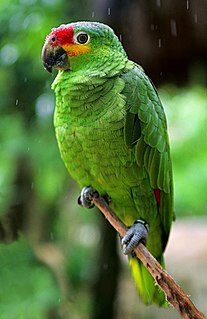 W
WThe red-lored amazon or red-lored parrot is a species of amazon parrot, native to tropical regions of the Americas, from eastern Mexico south to Ecuador where it occurs in humid evergreen to semi-deciduous forests up to 1,100 m altitude. It is absent from the Pacific side of Central America north of Costa Rica. Not originally known from El Salvador, a pair - perhaps escaped from captivity - nested successfully in 1995 and 1996 in the outskirts of San Salvador and the species might expand its range permanently into that country in the future. This species has also established feral populations in several California cities.
 W
WThe turquoise-fronted amazon, also called the turquoise-fronted parrot, the blue-fronted amazon and the blue-fronted parrot, is a South American species of amazon parrot and one of the most common amazon parrots kept in captivity as a pet or companion parrot. Its common name is derived from the distinctive turquoise marking on its head just above its beak.
 W
WThe white-fronted amazon also known as the white-fronted parrot, or by the adopted slang term spectacled amazon parrot, is a Central American species of parrot. Not to be confused with the red-spectacled amazon. They can imitate a range from 30 to 40 different sounds. Like other large parrots, the white-fronted parrot has a long potential life span, usually around 40 years.
 W
WThe yellow-headed amazon, also known as the yellow-headed parrot and double yellow-headed amazon, is an endangered amazon parrot of Mexico and northern Central America. Measuring 38–43 centimetres (15–17 in) in length, it is a stocky short-tailed green parrot with a yellow head. It prefers to live in mangrove forests or forests near rivers or other bodies of water. It is sometimes considered a subspecies of the yellow-crowned amazon. It is a popular pet and an excellent talker. Poaching for the international pet trade has driven the species to near-extinction in the wild; around half of all wild-caught birds are thought to die in the process. The yellow-headed amazon is CITES I listed, and there are legal restrictions on its trade and ownership, including a certification system.
 W
WThe budgerigar is a long-tailed, seed-eating parrot usually nicknamed the budgie, or in American English, the parakeet. Budgies are the only species in the genus Melopsittacus. Naturally, the species is green and yellow with black, scalloped markings on the nape, back, and wings. Budgies are bred in captivity with colouring of blues, whites, yellows, greys, and even with small crests. Juveniles and chicks are monomorphic, while adults are told apart by their cere colouring, and their behaviour.
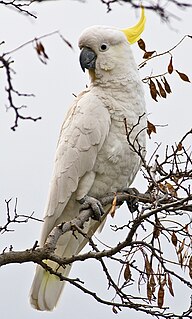 W
WThe sulphur-crested cockatoo is a relatively large white cockatoo found in wooded habitats in Australia, and New Guinea and some of the islands of Indonesia. They can be locally very numerous, leading to them sometimes being considered pests. A highly intelligent bird, they are well known in aviculture, although they can be demanding pets.
 W
WThe yellow-crested cockatoo also known as the lesser sulphur-crested cockatoo, is a medium-sized cockatoo with white plumage, bluish-white bare orbital skin, grey feet, a black bill, and a retractile yellow or orange crest. The sexes are similar.
 W
WThe rainbow lorikeet is a species of parrot found in Australia. It is common along the eastern seaboard, from northern Queensland to South Australia. Its habitat is rainforest, coastal bush and woodland areas. Several taxa traditionally listed as subspecies of the rainbow lorikeet are now treated as separate species, 6 species have now been identified.
 W
WThe blue-and-yellow macaw, also known as the blue-and-gold macaw, is a large South American parrot with mostly blue top parts and light orange underparts, with gradient hues of green on top of its head. It is a member of the large group of neotropical parrots known as macaws. It inhabits forest, woodland and savannah of tropical South America. They are popular in aviculture because of their striking color, ability to talk, ready availability in the marketplace, and close bonding to humans.
 W
WThe mitred parakeet, also known as the mitred conure in aviculture, is a species of green and red parrot in the family Psittacidae. It is native to the forests and woodlands in the Andes from north-central Peru, south through Bolivia, to north-western Argentina, with introduced populations in California, Florida and Hawaii. It may constitute a cryptic species complex.
 W
WThe Alexandrine parakeet, also known as the Alexandrine parrot, is a medium-sized parrot in the genus Psittacula of the family Psittacidae. It is named after Alexander the Great, who transported numerous birds from Punjab to various European and Mediterranean countries and regions, where they were prized by the royalty, nobility and warlords.
 W
WThe blue-crowned parakeet, blue-crowned conure, blue-crowned budgie, or sharp-tailed conure is a small green Neotropical parrot with a blue head and pale beak native to large parts of South America, from eastern Colombia in the north to northern Argentina in the south. They inhabit savanna-like habitats, woodland and forest margins, but avoid dense humid forest such as the Amazon.
 W
WThe monk parakeet, also known as the Quaker parrot, is a species of true parrot in the family Psittacidae. It is a small, bright-green parrot with a greyish breast and greenish-yellow abdomen. Its average lifespan is 20–30 years. It originates from the temperate to subtropical areas of Argentina and the surrounding countries in South America. Self-sustaining feral populations occur in many places, mainly in North America and Europe.
 W
WThe nanday parakeet, also known as the black-hooded parakeet or nanday conure, is a medium-small, mostly green, Neotropical parrot native to continental South America.
 W
WThe red-masked parakeet is a medium-sized parrot from Ecuador and Peru. It is popular as a pet and are better known in aviculture as the cherry-headed conure or the red-headed conure. They are also considered the best talkers of all the conures.
 W
WThe rose-ringed parakeet, also known as the ring-necked parakeet, is a medium-sized parrot in the genus Psittacula, of the family Psittacidae. It has disjunct native ranges in Africa and South Asia, and is now introduced into many other parts of the world where feral populations have established themselves and are bred for the exotic pet trade.
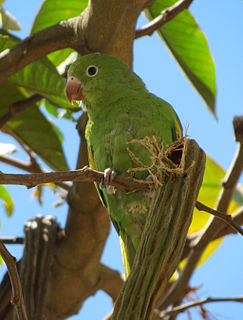 W
WThe yellow-chevroned parakeet is native to tropical South America south of the Amazon River basin from central Brazil to southern Bolivia, Paraguay, and northern Argentina. Caged birds have been released in some areas, and the birds have established self-sustaining populations in the Miami, Florida, and Los Angeles and San Francisco, California. This bird seems to be doing better in its North American feral population than the closely related white-winged parakeet. The species is also established in the downtown area of Rio de Janeiro, Brazil, where it was introduced. The native population in South America continues to do well.
 W
WFeral parakeets in Great Britain are wild-living, non-native parakeets that are an introduced species into Great Britain. The population consists of rose-ringed parakeets, a non-migratory species of bird native to Africa and the Indian Subcontinent. The origins of these birds are subject to speculation, but they are generally thought to have bred from birds that escaped from captivity.
 W
WThe crimson rosella is a parrot native to eastern and south eastern Australia which has been introduced to New Zealand and Norfolk Island. It is commonly found in, but not restricted to, mountain forests and gardens. The species as it now stands has subsumed two former separate species, the yellow rosella and the Adelaide rosella. Molecular studies show one of the three red-coloured races, P. e. nigrescens, is genetically more distinct.
 W
WThe eastern rosella is a rosella native to southeast of the Australian continent and to Tasmania.
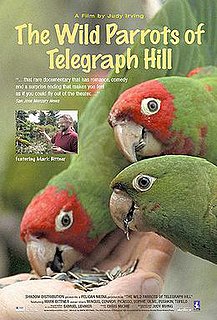 W
WThe Wild Parrots of Telegraph Hill is a 2003 documentary film directed, produced, and edited by Judy Irving. It chronicles the relationship between Mark Bittner, an unemployed musician who is living rent-free in a cabin in Telegraph Hill in San Francisco, California, and a flock of feral parrots that he feeds and interacts with—cherry-headed conures, mainly, but also two blue-crowned conures, one of which is named Connor. Bittner also wrote a book by the same name on the subject.